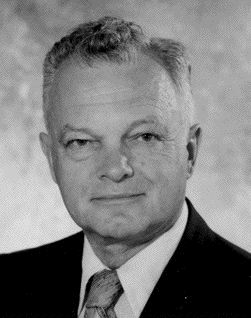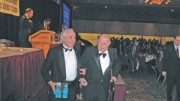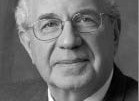The Canadian Mining Hall of Fame marked its 20th anniversary by inducting five new members whose expertise ranged from grassroots exploration to open pit engineering, and whose work took them from the mountains of British Columbia to the Zambian copper belt.
In what is becoming an annual gig, former Newmont Mining president and gold industry legend Pierre Lassonde presided over the event, and guided the crowd of 700 from laughter to gravity with a skill that should make Hall of Fame organizers worry that their counterparts at the Oscar Awards might steal him away.
The first inductee Lassonde called to the podium was Carroll “Chuck” Brawner.
Born in Saskatoon, Sask., Brawner went east to Nova Scotia in 1929, earning a master’s degree in soil mechanics before heading back west to test his skills at some of the toughest soil conditions in the country — B.C.’s mountains.
Brawner met the civil and mining engineering challenges associated with the steep mountain slopes head on, and his experiences led him to co-found what would become Golder Associates — a leading consulting firm specializing in open-pit mines. While at Golder, he solidified his reputation as an expert on the design, construction and maintenance of tailings dams — issues that remain close to his heart.
In his acceptance speech, Brawner made it clear that the industry cannot afford a repeat of any of the tailings dam breakdowns that have occurred in the recent past.
“To minimize risk, many companies are now performing annual geotechnical reviews. I was on the geotechnical review board for Syncrude Canada for 31 years. . . and I’m still available for such assignments,” Brawner said to a laughing audience.
The second man honoured during the evening was geologist Johannes Brummer (1921-2005). Known as a straight shooter who loved to get out into the field — even after his credentials moved him up the corporate ladder — Brummer ranks as one of Canada’s great exploration geologists, credited with playing a key role in the discovery of 10 mineral deposits.
Born in South Africa in 1921, Brummer started his career on the Zambian copper belt after graduating from Witwatersrand University.
The mark he was to make in later years in Canada was already surfacing early in his academic career, as he challenged the prevailing hydrothermal model used on the copper belt at the time by creating the unconformity and stratabound model. The model inspired a change in thinking that led to the discovery of several new deposits in South Africa.
But the chance to do his doctorate at McGill University lured Brummer from the warmth of sub-Saharan Africa to the cold of the Great White North in 1953. Two years later, he started work with Kennco Explorations, where he introduced stream-sediment geochemistry to Canada.
Brummer had once again delivered a new perspective that brought tangible results, as the approach led to the discovery of large porphyry copper and copper-gold deposits in the Western Cordillera.
By 1961, he had joined Falconbridge Nickel Mines and helped uncover three new deposits in Manitoba and the George Lake zinc deposit in Saskatchewan — the last being a harbinger of what was to come in the prairie province.
He carried his success over to Canadian Occidental, where, pioneering a technique roughly equivalent to today’s electro-magnetic survey, he directed the drills into the Athabasca basin and discovered the McClean Lake and JEB uranium deposits.
Former colleague Roger Wallis shed some light on how Brummer, who passed away in 2005, was able to make so many key discoveries.
“Joe was willing to try new methods, he was willing to give it a go. . . Joe was willing to look for orebodies in really unconventional rocks,” Wallis explained.
Another miner with a Falconbridge connection, Ernest Craig (1888-1960), was presented after Brummer. Craig was the first general manager of the Falconbridge nickel mine and was a key member of the team that built the mine and town site that formed the backbone of the mining giant, now part of Xstrata (xsraf-o, xta-l).
One of 12 children born in Kearney, Ont., Craig left home at a young age, heading to northern Ontario to make a living in the emerging mining camps.
He eventually caught the attention of mine finder and Canadian Hall of Fame inductee Thayer Lindsley, who would later appoint Craig general manager.
Craig is credited with helping to transform the Falconbridge site into a world-class mining complex — not an easy task considering the site was so remote that it wasn’t even a part of a municipality. Basic services and infrastructure were all established with Craig’s help.
A strong believer in corporate responsibility long before it had social cachet, Craig was known as “Town Father” for his efforts in the community — efforts that were commemorated by Falconbridge in 1993 when it named its largest mine after him.
But Craig’s prowess wasn’t limited to big projects like the building of communities — he also took on the smaller ones. Along with his brother Robert, he designed the Craig bit — a detachable drill bit that increased productivity by doing away with the need to sharpen steel rods in underground drilling.
“We need more guys like this,” Lassonde said, as he rhymed off a list of Craig’s achievements.
Ian Pierce, chief executive of Xstrata Nickel, acknowledged Craig for helping to turn Falconbridge into an industry leader.
“He knew every employee on a first-name basis,” Pierce said. “His visionary leadership helped transform northern Ontario by contributing to the building of a hospital and a school, as well as establishing the Falcona summer camp for children of employees — which continues today — and fostered an excellent reputation for Falconbridge that we are proud to carry on today.”
Craig’s granddaughter, Susan Senior, reflected on the more playful side of his personality. She told of a prized possession Craig won in a bet, after carrying a live skunk under his arm down the main street of Timmins.
Senior pulled out an old top hat — the prize claimed for the feat — and held it over her head, offering:
“We tip this hat to you tonight, Papa, in a toast from your family. We are so proud.”
If there were a trophy for the most spirited inductee, Chester Millar would have had to find room for it on his shelf beside his Hall of Fame Award.
Known for discovering deposits and building open pits from Kamloops down to Honduras, Millar’s years in the field led him to some harsh conclusions about the role the stock market plays in the industry.
He berated the Street for making companies mine too quickly, and not considering their inherent obligations to the communities they work in.
“I think mining companies are in danger of leaving a bad impression, by going down to these places and very quickly building mines and leaving them with nothing. . . We should not let the stock exchange tell us guys how to run a mine,” he said.
Millar vaulted onto the mining stage with the discovery of the Afton copper-gold deposit, near Kamloops, in the mid-1960s.
While Teck Corp. (now Teck Cominco [tck.b-t, tck-n]) dashed Millar’s hopes of seeing the deposit through to production by acquiring it in the early ’70s, Millar carried on and headed south, to the western U.S. There, he pioneered the use of heap leaching for low-grade gold ores.
Yearning to spread the technique farther afield, Millar went to Latin America to start projects in Honduras and Mexico, publishing a technical book on heap leaching in Spanish along the way.
He also helped transform Glamis Gold and Eldorado Gold (ELD-T, EGO-X) from juniors to gold producers and was part of the early growth of Alamos Gold (AGI-T, AGIGF-O) — and through all of it, he kept the interests of the communities his companies worked in, close to his heart.
Alamos Gold chief executive, John McCluskey, attested to Millar’s social commitment by relating a story of a Ho
nduran mine the two were involved in during the 1980s.
McCluskey had expressed concern that the mine would never be profitable and that even if it was, they would have a hard time getting the money out of the country — only to have Millar come back with a logic every bit as revealing as it was unique.
” ‘I’m here for other reasons,’ ” Millar said. ” ‘That mine employs 500 people. Think of all the families that have a decent standard of living because of those jobs. . . There’s a lot more dignity in holding a job than getting a handout.’ ”
“That says more about this man than most things I could think of for this introduction,” McCluskey concluded.
Last at the podium was Teck and Teck Cominco’s long-time numbers man, David Thompson.
Thompson worked his way up from vice-president of finance at Teck Corp. to chief executive of Cominco, then to deputy chairman and chief executive of Teck Cominco — a position he held until his retirement in 2005.
Thompson’s lofty status in the industry gave Lassonde the perfect opportunity to stoke a roasting fire.
“David been has been described as the sharpest pencil in the business,” Lassonde said with a wry smile. “Now that’s the very charitable definition. Others say that he has the compassion of an icicle and the generosity of a pawnbroker.” Once the laughter had died down, Lassonde prodded the flames a little more, saying, “He’s so tight that when he walks he squeaks.”
Lassonde’s quips were balanced by praise from Teck Cominco chairman Norman Keevil, who lauded Thompson for his keen business sense.
Regarded as one of the industry’s top strategists, Thompson structured deals throughout the 1990s that helped Teck move into the metallurgical coal field. And it was Thompson who helped orchestrate Teck’s acquisition of 31% of Cominco’s stock in 1986, a move that paved the way for the merger that took place 14 years later.
Born in London, England, in 1939, Thompson graduated from the London School of Economics and then went to Harvard Business School.
He joined Teck in 1980, after working with a copper mining company in South Africa and stayed within Teck’s inner circle until his retirement.
Those years gave him a front-row seat from which he watched one of Canada’s most important mining families, the Keevils.
Thompson recalled a telling exchange he had with Norm Keevil Sr. about trying to adjust the company’s image so the big banks would be more inclined to do business with them.
“I told (Keevil) Sr. that perhaps it would be a good idea if we had a more staid, more conservative image in the public’s mind.
“Norman said, ‘We can do this. I have an interview with the Financial Post next week.’
“And sure enough, ten days later, he called me in to show me the article.
“There on the left side, was a full-page photograph of (Keevil) Sr. smiling comfortably, and on the right-hand side, in letters an inch thick was the title — and it said ‘The River Boat Gambler’.
“I don’t know what the banks thought at the time, but it certainly impressed the retail investors, because our stock went so high.”
With the addition of Brawner, Brummer, Craig, Millar, and Thompson, the Canadian Mining Hall of Fame expands to 136 members. Biographies can be found at www.halloffame.mining.ca.
The Hall is currently located on the ground floor of the mining building at the University of Toronto, but will be moving to the Royal Ontario Museum at the end of the year.
The hall has four main sponsors: the Canadian Institute of Mining, Metallurgy and Petroleum, the Mining Association of Canada, the Prospectors and Developers Association of Canada and The Northern Miner.
A board of directors, comprising 12 members appointed by the four sponsors, conducts the business of the Canadian Mining Hall of Fame.






Be the first to comment on "Mining Hall of Fame celebrates 20th anniversary"